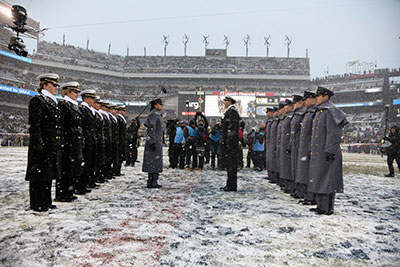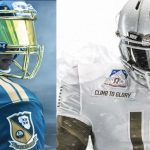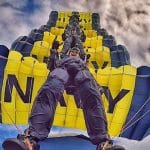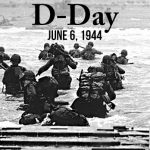It’s Winter 2018. Two mighty forces are preparing to collide on the battlefield for the 118th time. Both sides have lifted the spirits of their troops with pre-battle speeches. At the kickoff, they will be foes. When it’s over, brothers.
It is often referred to as the ‘only game where all the guys playing on the field are willing to die for all those watching game.’
This is the Army-Navy Game. It features two formidable opponents with a great history of battling each other since 1890. Not only do these two forces relish the combat they share on the gridiron but they also honor the history of both services through unique uniform selections each year.
Last year, the Army Black Knights celebrated the 10th Mountain Division and the Navy Midshipmen chose to honor the Blue Angels aerial demonstration team. This year, Navy salutes Bill the Goat, its team mascot since 1893. The Army’s 1st Division, the Big Red 1 (founded in 1917) will be represented on Army’s uniform.
Watch Video 2018 Army-Navy Game Uniform: First Infantry Division
Watch Video: Victory Day: Go Navy, Beat Army!
Video – An Excellent Introduction of the Army-Navy Game
9 Historical Traditions of the Army-Navy Game
- Record – They have met each other on the gridiron battlefield 118 times. Since their first game on November 28, 1890, Navy has won 60 times, Army 51, and they have tied 7 times.
- Location – The attendance for this game normally exceeds 81,000. Because Army’s Michie Stadium seats 38,000 and the Navy-Marine Corps Memorial Stadium only 34,000, the Army-Navy game is traditionally played at a neutral site in Philadelphia or Baltimore. Last year in Baltimore it was held in the NFL’s Baltimore Ravens stadium. This year it is at Lincoln Financial Field, home of the NFL’s Philadelphia Eagles.

The Prisoner Exchange prior to the Army-Navy Game
The Prisoner Exchange – Only with the Army-Navy game do you have a tradition of exchanging prisoners. In their Junior year, a select group of cadets and midshipmen spend a semester studying at their sister academies. During the pre-game activities, these students take part in a prisoner swap on the field, returning to their own schools and joining their classmates in the stands.
- The March-on – During the game, the Cadets and Midshipmen will be in uniform. Prior to the beginning of the game, both academies will march into the stadium in tight columns and fill the stands. It is truly an emotional sight to see these young men and women enter the stadium.
- Halftime Walk – Since 1901 when Theodore Roosevelt did it, the President or Secretary of Defense march across the field to make sure they sit on both the Navy and the Army’s side of the field. As the President enters, the bands will play “Hail to the Chief.” When the President changes sides at halftime, the service academies cheer.
- Sing 2nd! – At the conclusion of the game, all the players meet in the middle of the field in a show of solidarity. They all face the stands of the losing team and sing that school’s alma mater. Upon completion, they then turn completely around and sing to the victor school’s alma mater to winning academy’s stands – hence the call to “sing second.”
- Academics, Size, and Military Service – Both the Army and the Navy teams have been quite dominant in college football in the past. In 1944 and 1945, Army was ranked No. 1 and Navy No. 2 in the country. The Army earned three national titles in 1944, 1945, and 1946. The Navy has one National title in 1926. Between the two, they have had five Heisman Trophy winners. But, as college football players have gotten much bigger over the years, the service academies are required to recruit within their military size requirements, and their dominance has waned as a result.
- Size Matters – An NCAA Division 1 offensive lineman that is 6’1” – 6’4” will average 290 pounds. At the big D1 schools who dominate the college football rankings, linemen may average closer to 305-310 lbs. Compare that to a 6’5” Midshipmen lineman who, according to Navy Body Composition Assessment, should weigh no more than 226 lbs. Though some of those linemen may reach an average of 285 lbs, small according to D1 standards, the players will be required to lose the excess weight between their last eligible game and graduation. This means a lineman may have to lose 50 or 60 lbs in a 6 month period to meet size standards and fulfill their five years of military service requirement following college.
- High Academics Standards – The service academies also have high academic requirements similar to Ivy League schools. Though they recruit players similar to Duke, Northwestern, and Stanford, these schools do not have the required 5 years of military service and the size restrictions that can impede landing the top prospects in the country. Still, the Air Force, Army, and Naval Academies compete quite well within the NCAA. Academy Head Coaches Explain Football’s 3 Hardest Jobs








